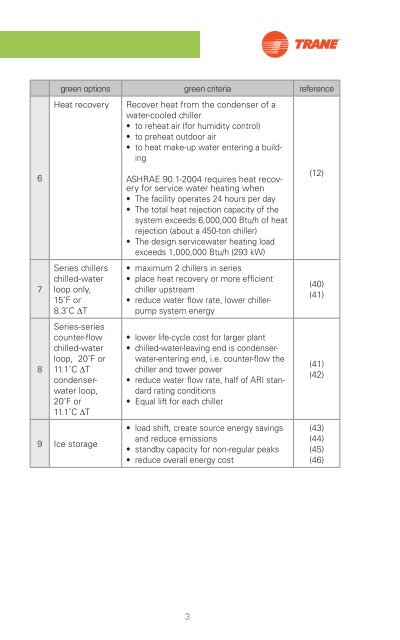HVAC - Resource Guide For Green Building Design - Trane
HVAC - Resource Guide For Green Building Design - Trane HVAC - Resource Guide For Green Building Design - Trane
EARTHWISE SYSTEMS CHILLED-WATER SYSTEMS (CWS) green options green criteria reference 1 2 Reduce waterflow rate in chilled-water loop (12-20˚F, or 6.7-11.1˚CΔT) condenser water loop (12-18˚F or 6.7- 10˚CΔT) Variable flow chilled-water systems Vary the water flow rate through the chiller evaporators during system operation • Increase efficiency of chilled-water plant so that pumps and cooling towers consume less energy • Reduce building materials (smaller pump, cooling tower, fan) • Reduce water pipe sizes, save cost and material Reduce system materials required, using fewer pumps than the common primarysecondary system; for example, reduced • piping connections • strainers • electrical connections • valves and specialties • pump starters • space required Improve system efficiency modestly by reducing pumping energy. (1) (2) (3) (4) (5) (6) (7) 3 System optimization controls Condenser water temperature reset and optimization • Improve system efficiency • Optimize the condenser water system by balancing the chiller and tower power • Iterate for the best condenser water temperature to minimize the combined chiller-tower energy use at all time (8) (9) 4 Pumping pressure-speed reset • Reset the pump operating pressure to ensure that the control valve needing the highest pressure is about 90% open • Save pump energy (10) 5 Refrigerant charge per ton Select systems that require less refrigerant charge to operate • Less refrigerant means less impact on the environment in case refrigerant leaks from the system • Use ASHRAE Standard 147 to further minimize leakage or overall refrigerant emissions (11) 2
6 7 8 green options green criteria reference Heat recovery Series chillers chilled-water loop only, 15˚F or 8.3˚C ΔT Series-series counter-flow chilled-water loop, 20˚F or 11.1˚C ΔT condenserwater loop, 20˚F or 11.1˚C ΔT 9 Ice storage Recover heat from the condenser of a water-cooled chiller • to reheat air (for humidity control) • to preheat outdoor air • to heat make-up water entering a building ASHRAE 90.1-2004 requires heat recovery for service water heating when • The facility operates 24 hours per day • The total heat rejection capacity of the system exceeds 6,000,000 Btu/h of heat rejection (about a 450-ton chiller) • The design servicewater heating load exceeds 1,000,000 Btu/h (293 kW) • maximum 2 chillers in series • place heat recovery or more efficient chiller upstream • reduce water flow rate, lower chillerpump system energy • lower life-cycle cost for larger plant • chilled-water-leaving end is condenserwater-entering end, i.e. counter-flow the chiller and tower power • reduce water flow rate, half of ARI standard rating conditions • Equal lift for each chiller • load shift, create source energy savings and reduce emissions • standby capacity for non-regular peaks • reduce overall energy cost (12) (40) (41) (41) (42) (43) (44) (45) (46) 3
- Page 1 and 2: GREEN BUILDING HVAC Resource Guide
- Page 3: PREFACE Trane values guide us in ou
- Page 8 and 9: EARTHWISE SYSTEMS AIR-HANDLING SYST
- Page 10 and 11: EARTHWISE SYSTEMS DX UNITARY SYSTEM
- Page 12 and 13: CONTROL STRATEGIES ENERGY MANAGEMEN
- Page 14 and 15: EQUIPMENT UNITARY HEAT PUMP EFFICIE
- Page 16 and 17: EQUIPMENT ELECTRIC CHILLER EFFICIEN
- Page 18 and 19: REFRIGERANTS refrigerant theoretica
- Page 20 and 21: HVAC IMPACT on LEED ® LEED FOR NEW
- Page 22 and 23: HVAC IMPACT on LEED ® LEED FOR EXI
- Page 24 and 25: HVAC IMPACT on LEED ® LEED FOR COR
- Page 26 and 27: ENERGY MODELING FEATURES OF TRACE
- Page 28 and 29: ASHRAE 90.1-2004 APPENDIX G TABLE G
- Page 30 and 31: REFERENCE REFERENCE 1. CoolToolsTM
- Page 32 and 33: REFERENCE 43. MacCracken, M. M. 200
- Page 34 and 35: NOTES: 30
- Page 36: Literature Order Number............
6<br />
7<br />
8<br />
green options green criteria reference<br />
Heat recovery<br />
Series chillers<br />
chilled-water<br />
loop only,<br />
15˚F or<br />
8.3˚C ΔT<br />
Series-series<br />
counter-flow<br />
chilled-water<br />
loop, 20˚F or<br />
11.1˚C ΔT<br />
condenserwater<br />
loop,<br />
20˚F or<br />
11.1˚C ΔT<br />
9 Ice storage<br />
Recover heat from the condenser of a<br />
water-cooled chiller<br />
• to reheat air (for humidity control)<br />
• to preheat outdoor air<br />
• to heat make-up water entering a building<br />
ASHRAE 90.1-2004 requires heat recovery<br />
for service water heating when<br />
• The facility operates 24 hours per day<br />
• The total heat rejection capacity of the<br />
system exceeds 6,000,000 Btu/h of heat<br />
rejection (about a 450-ton chiller)<br />
• The design servicewater heating load<br />
exceeds 1,000,000 Btu/h (293 kW)<br />
• maximum 2 chillers in series<br />
• place heat recovery or more efficient<br />
chiller upstream<br />
• reduce water flow rate, lower chillerpump<br />
system energy<br />
• lower life-cycle cost for larger plant<br />
• chilled-water-leaving end is condenserwater-entering<br />
end, i.e. counter-flow the<br />
chiller and tower power<br />
• reduce water flow rate, half of ARI standard<br />
rating conditions<br />
• Equal lift for each chiller<br />
• load shift, create source energy savings<br />
and reduce emissions<br />
• standby capacity for non-regular peaks<br />
• reduce overall energy cost<br />
(12)<br />
(40)<br />
(41)<br />
(41)<br />
(42)<br />
(43)<br />
(44)<br />
(45)<br />
(46)<br />
3



